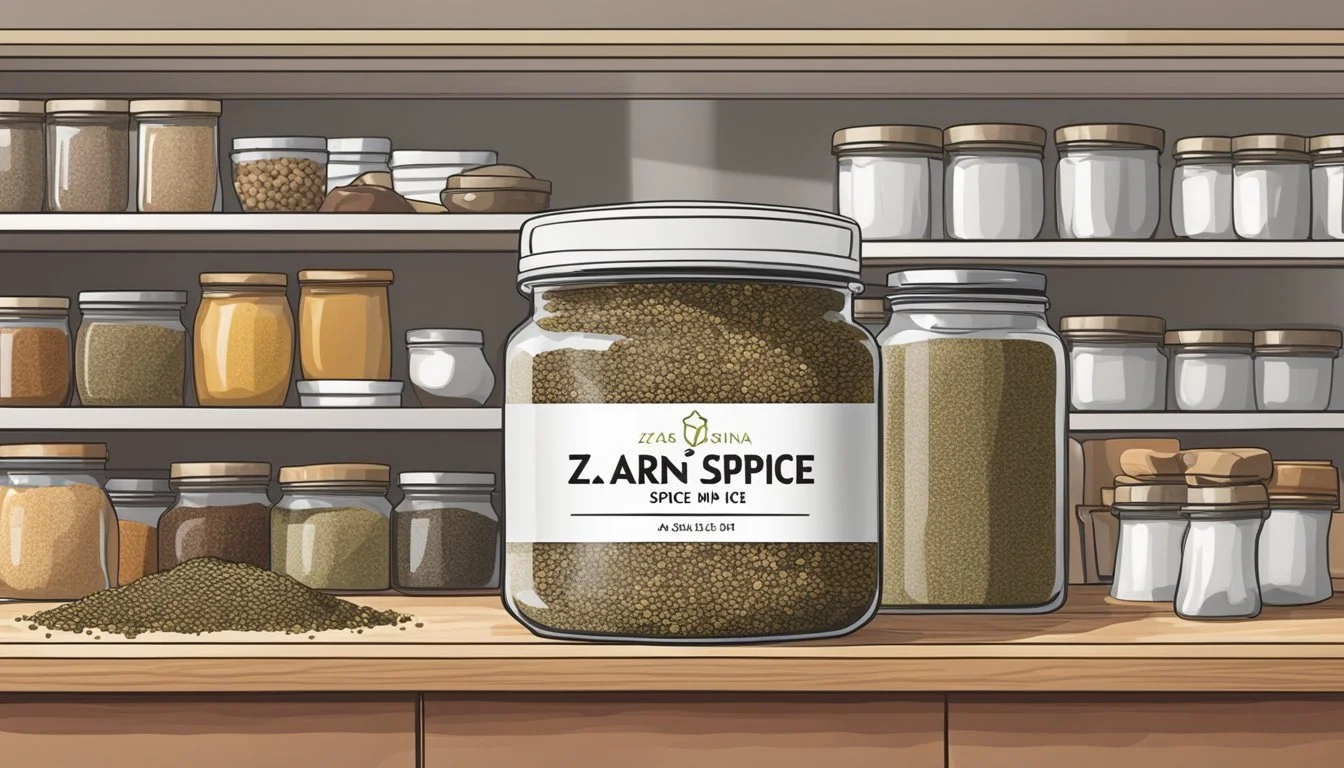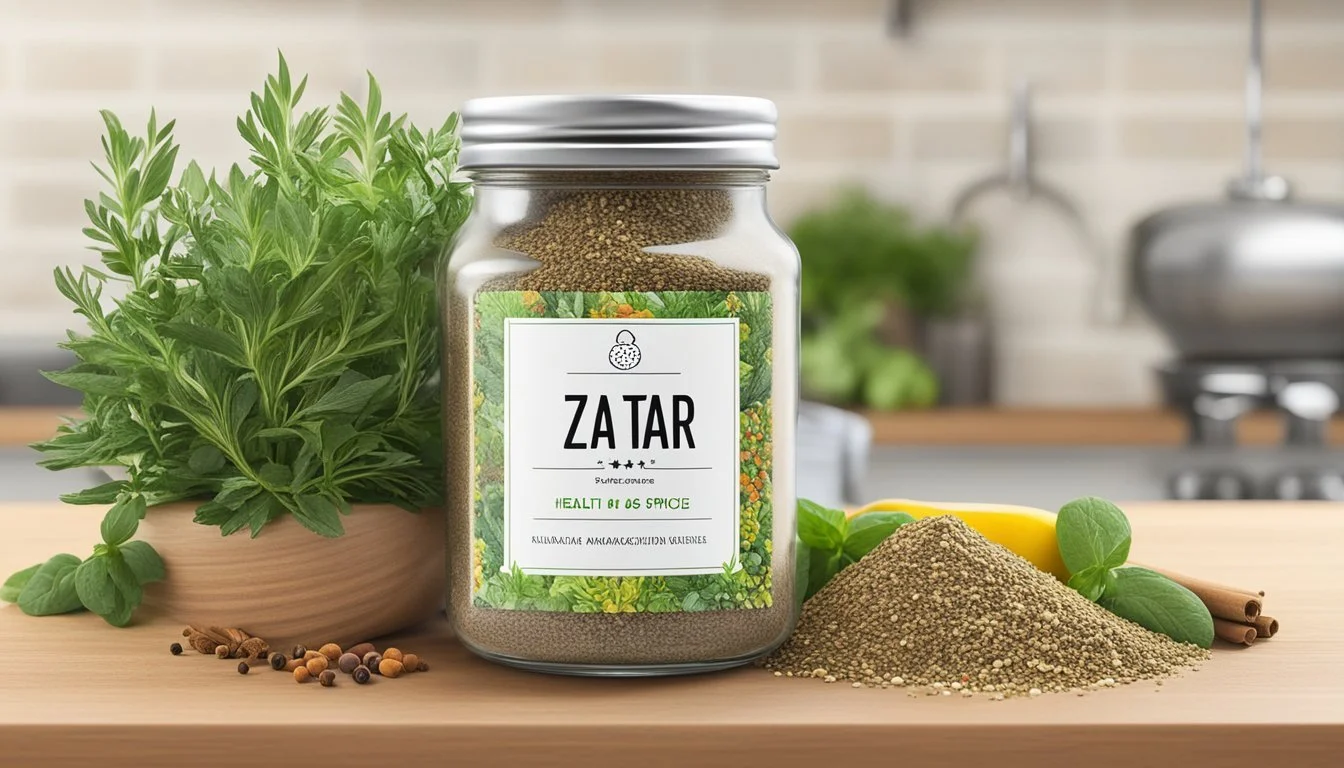How Long Does Za'atar Spice Mix Last?
Shelf Life and Storage Tips
Za'atar is a Middle Eastern spice blend known for its dynamic flavor profile that combines earthy, herby, and tangy notes. This versatile mixture typically includes herbs such as thyme, oregano, marjoram, paired with sesame seeds (how long do seeds last?), and often sumac for its lemony zest. The spice has become increasingly popular in global cuisine, finding its way into numerous dishes both as a seasoning and a finishing touch.
Understanding the shelf life of Za'atar is important because the longevity of its flavors can impact the taste of the dishes it is used in. Generally, like most dried herb and spice blends, Za'atar can last a long time when stored properly. The factors that affect its shelf life include the freshness of the individual components at the time of mixing, the environment in which it's stored, and how it is packaged.
For optimal flavor preservation, it is recommended that Za'atar be stored in an airtight container, away from direct sunlight and heat. This approach helps maintain the integrity of the spice mix and prevent the degrading of its aromatic qualities. Properly stored, Za'atar can keep its potency and vibrant character for several months, ensuring that its distinctive flavor can be enjoyed in an array of Middle Eastern and fusion culinary creations.
Understanding Za'atar Spice Mix
Za'atar spice mix is a traditional Middle Eastern blend that has a rich history and varies in composition based on the region. It is an aromatic symphony of herbs and spices that forms an integral part of Middle Eastern cuisine.
Historical Significance
Za'atar has a storied past that dates back to ancient civilizations. It was not only valued for its flavor but also for its presumed health benefits and has been used in traditional medicinal practices. Historical references to similar herb mixtures in Middle Eastern texts illustrate its long-standing presence in the region's culinary traditions.
Common Ingredients
The base ingredients in a typical za'atar spice mix tend to include:
Dried oregano
Dried thyme (how long does dried thyme last?)
Sumac for its tangy flavor
Sesame seeds (how long do sesame seeds last?) for a nutty crunch
Salt, which enhances the overall taste profile
These components are blended together to create a harmonious mix that is versatile in its uses.
Variations Across Regions
Za'atar recipes may vary significantly across the Middle East, reflecting local tastes and traditions. For instance, some regional variations might include:
Marjoram, which is often included in Levantine za'atar blends
Additional herbs such as savoury
Despite these differences, the essence of the za'atar spice mix remains rooted in the combination of herbs and spices deeply entrenched in the Mediterranean and Middle Eastern food cultures. Each variation of za'atar holds its unique place in the culinary heritage of the region where it is created.
Culinary Uses of Za'atar
Za'atar spice mix is a staple in Middle Eastern cuisine, known for its savory, earthy flavor with a tangy undertone. This versatile seasoning lends itself well to various culinary applications, from traditional dishes to modern cuisine.
Traditional Pairings
Middle Eastern cultures have long celebrated za'atar for its ability to enhance the flavors of simple ingredients. A classic use involves mixing za'atar with olive oil to create a spread for bread. This blend is often paired with labneh, a thick, creamy yogurt-based cheese. Za'atar is also traditionally sprinkled over hummus, enhancing its earthy taste. In breakfast meals, it is commonly added to eggs, either scrambled or boiled.
Bread Spread: Olive oil and za'atar
Dairy Enhancement: Yogurt, labneh, and cheese
Hummus Topping: Sprinkled on top for extra flavor
Modern Adaptations
Modern cuisine has embraced za'atar, incorporating it into Western dishes with a Middle Eastern twist. For instance, it has become a popular addition to avocado toast, offering a new flavor dimension. Pizza topped with za'atar, alongside other ingredients like cheese, brings a unique, tangy taste to the Italian staple. It's also used to season grilled meats (What wine goes well with grilled meats?) or combined with olive oil as a marinade to impart its distinctive flavor. Creative chefs even use za'atar as a salad dressing base, infusing greens with its nutty and zesty notes.
Avocado Toast: Sprinkle za'atar for a savory touch
Pizza Seasoning: A Middle Eastern twist to pizza
Meat Marinade: Olive oil and za'atar for grilled meats
Recipes and Preparation
Za'atar is versatile in recipes, both as a primary seasoning and as a complement to other flavors. It's commonly used to marinate chicken before baking or grilling, which allows the meat to absorb its aromatic elements. The spice mix can also be baked onto bread or combined with cheese for a well-seasoned pastry filling. Additionally, za'atar can be effortlessly stirred into salad dressings, giving salads an uplifted taste profile with its earthy and tangy characteristics.
Chicken Marinade: Za'atar for flavor-infused poultry
Bread Making: Baked with bread or as a topping
Cheese Pastry Filling: Combined with cheese for a rich flavor
Storage and Shelf Life
To maintain the potency and quality of Za'atar spice mix, it is essential to adhere to proper storage methods and be aware of its shelf life expectancy. Recognizing signs of spoilage can help ensure that Za'atar is always used at its peak flavor.
Optimal Storage Conditions
Za'atar, a blend most commonly consisting of dried thyme, dried oregano, sesame seeds, and sumac, requires a cool, dry environment to preserve its quality. An airtight container is paramount to prevent the spice mix from absorbing moisture from the air. This mix should be stored away from direct heat or sunlight, as prolonged exposure can degrade the essential oils that contribute to Za'atar's distinct taste and aroma.
Shelf Life Expectancy
When stored under ideal conditions, Za'atar retains its potency for:
Dried thyme, oregano, and marjoram: up to 1-3 years
Toasted sesame seeds: approximately 1 year
Ground sumac: up to 2-3 years
One can extend the shelf life by refrigerating the spice mix, though it's generally not necessary. For even longer storage, freezing in an airtight container can retain quality for several months beyond pantry shelf life.
Signs of Spoilage
One should be vigilant for signs that Za'atar may no longer be fit for use. These include:
Mold: Any visible mold growth suggests moisture contamination which can be harmful.
Odor: A lack of the characteristic aromatic scent or an off smell is an indicator of spoilage.
Taste: A significant reduction in potency or a stale, disagreeable flavor can signify that the seasoning has passed its prime and should be replaced to maintain the desired culinary outcomes.
Health Benefits and Nutritional Value
Za'atar is a Middle Eastern spice blend known for its robust flavor and health benefits. This mix typically includes oregano, sumac, and sesame seeds among other herbs. Its consumption is associated with various positive health impacts and a unique nutritional profile.
Nutrients in Za'atar
Za'atar features a range of nutrients essential for health. The primary ingredients contribute the following:
Oregano: Rich in fiber, antioxidants, and flavonoids.
Sumac: Contains antioxidants; it's a tangy spice often used for its medicinal properties.
Sesame Seeds: High in protein, healthy fats, fiber, and minerals like calcium.
Each component brings a unique set of nutrients that complements the blend, contributing to the overall nutritional value of Za'atar.
Health Impacts
The consumption of Za'atar has been associated with several health benefits:
Antioxidant Properties: The herbs in Za'atar are high in antioxidants which help in combating oxidative stress.
Digestive Health: The fiber in oregano aids digestion, while sumac has been used traditionally to soothe upset stomachs.
Cognitive Boost: Ingredients such as oregano in Za'atar may contribute to improved cognitive function, although research is ongoing.
Heart Health: Sumac's potential to influence blood pressure and blood sugar regulation can be beneficial for heart health.
Immune Support: The herbal mix, with its antioxidant properties, is believed to strengthen the immune system.
In summary, Za'atar's unique combination of herbs, seeds, and spices not only adds a nutty, Mediterranean flavor to dishes but also provides various nutrients and health benefits.
Making Homemade Za'atar Blend
The creation of a homemade Za'atar blend revolves around the use of quality ingredients and proper preparation techniques. It's important to customize the blend to one's personal taste while adhering to the traditional flavors characterized by its herbal, tangy, and slightly lemony flavor profile.
Ingredient Selection
When selecting ingredients for a homemade Za'atar blend, one should prioritize quality. The blend primarily consists of dried thyme, toasted sesame seeds, and ground sumac. Each component should be fresh and of high quality to ensure the blend's distinctiveness. Sea salt (how long does sea salt last?) is often added for enhanced flavor, but its quantity should be adjusted according to personal taste.
Dried Thyme: A key ingredient, provides an earthy and savory base.
Toasted Sesame Seeds: Adds a subtle crunchiness and nutty flavor.
Ground Sumac: Imparts the characteristic tangy and lemony notes.
Sea Salt: Balances and intensifies the blend's flavors.
Preparation Techniques
One can either use a spice grinder or a mortar and pestle to combine the Za'atar blend. When preparing the spices, the dried thyme should be adequately crushed for a consistent texture while still allowing for some larger fragments to remain for bursts of flavor. If using a grinder, pulse the spices to avoid overheating, which can lead to a loss of aromatic oils.
Toast sesame seeds: Toast lightly until golden for an intensified flavor.
Grind dried thyme: Coarsely grind to release flavor without turning into a powder.
Mix with sumac and salt: Combine with ground sumac and sea salt in a bowl.
Customizing the Blend
Customization of a Za'atar blend hinges on personal preference and the intended use of the spice mix. Some may prefer a more pronounced lemony note from the sumac, while others enjoy a heavier presence of thyme or sesame seeds.
To increase the lemony flavor, add more ground sumac.
For a more robust herbal character, include more dried thyme.
Adjust the sea salt to taste, being careful not to overpower the other spices.
Each batch of homemade Za'atar is an opportunity to fine-tune the balance of herbal, nutty, and tangy elements inherent to this Middle Eastern culinary staple.





